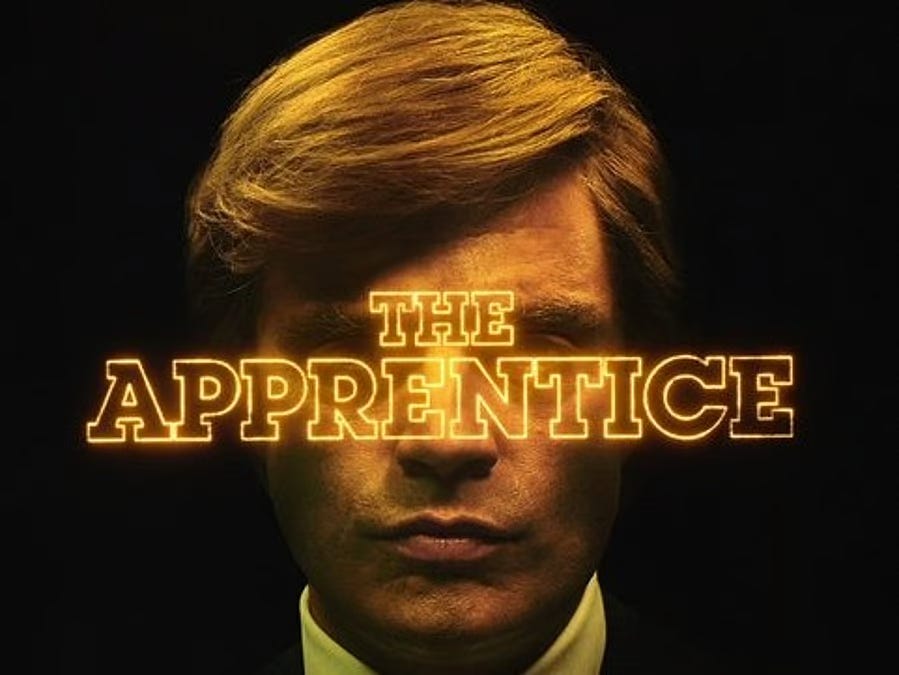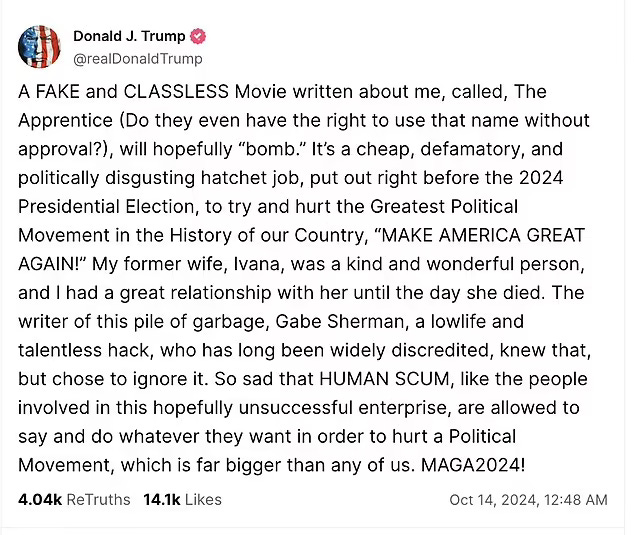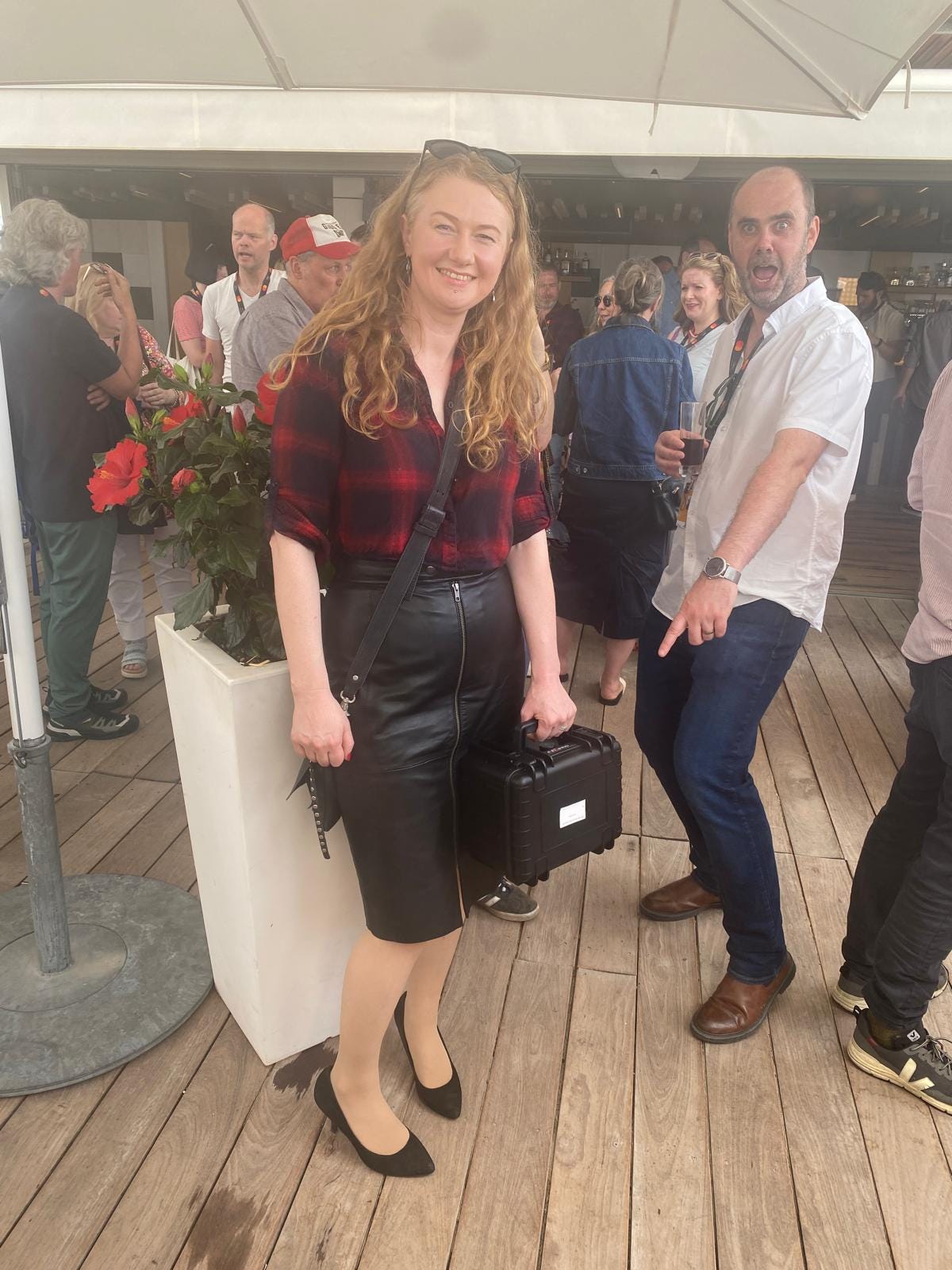Cannes Do: How an Irish Co-Production Helped Get Trump into Cannes.
An interview with the makers of The Apprentice about how they turned the film around for a Cannes Premiere in ultra-quick time frame.
The following is an interview I did for Assembled magazine. Issue Number 05 of Assembled, the magazine from Irish Screen Editors, has an international flavour featuring an interview with with Irish post-producer Clodagh McCarthy; Iranian film editor Hamid Najafirad and Patryk Czekalski; a Polish-born assistant editor based out of London. Assembled also features a summary of the Dublin Editors In Conversation series from last year.
As half of the founding partnership behind Tailored Films, Julianne Forde has produced feature films and TV series for over a decade. As a producer, she’s no stranger to criticism—but she’s never before been called “human scum,” least of all by a president of the United States of America.
On 14th October last year, Donald Trump tweeted about “A FAKE and CLASSLESS Movie” calling it “a cheap, defamatory, and politically disgusting hatchet job.” The film in question is The Apprentice, which chronicles Trump’s evolution in the 1970s and 1980s from an ambitious young real estate heir to a prominent figure in New York’s business scene. Central to this transformation is his relationship with lawyer Roy Cohn, whose aggressive tactics significantly influenced Trump’s future character.
While The Apprentice doesn’t seem at first glance like a natural fit for Irish involvement, it is one of a growing number of acclaimed productions—like Poor Things, Shōgun, Evil Dead Rise, and Rick and Morty—that have benefitted from Irish involvement and financing.
From grading and mixing to a significant portion of the visual effects, The Apprentice owes much of its success to Irish production expertise.
“We didn’t develop the script,” says Forde. “The reason it became a three-way international co-production between Canada, Ireland, and Denmark is because they couldn’t finance it in the United States.” Written by New Yorker and Vanity Fair journalist Gabe Sherman, the film originated from his curiosity about how a figure like Trump came to be. Sherman’s research into Trump’s relationship with the infamous Roy Cohn revealed traits of Cohn reflected in Trump.
Julianne Forde and her Tailored Films co-founder, Ruth Treacy, joined the project relatively late in the process. “We were actually the last partner in the co-production structure,” says Forde. “Ali Abbasi, the director, is based in Denmark, so it was a Danish setup, filmed in Canada to represent New York. We met Daniel Beckerman, the Canadian producer, when they were seeking a third co-production partner. We connected at Cannes in May 2023, so it was an incredibly fast turnaround. We were particularly excited to work with Ali, which is why we pitched so hard to be part of the project.”
Tailored Films has grown considerably since Forde and Treacy set it up after studying together in Dún Laoghaire. Initially focused on corporate videos, short films, and summer filmmaking courses, Tailored Films is now one of Ireland’s most exciting independent production companies. In 2024, alongside The Apprentice, they released Bring Them Down (starring Barry Keoghan and Colm Meaney) and the YA series Louise Lives Large for RTÉ . As with many Irish productions, parts of these projects were completed in Ireland, with other elements handled abroad.
“It’s all about the budget,” Forde explains. “You can do everything in Ireland, but when you need to hit a higher budget level, that’s where co-productions come in. They bring in additional financing. These projects use what’s called ‘jigsaw financing,’ with many small pieces coming together. These decisions impact what parts of the production happen in Ireland versus abroad. For example with Bring Them Down, we were involved in the development and looked after the entire shoot. When it came to post production, and of course we fed in with notes and review, but it was lovely to be able to hand it over to the Belgium and the UK and say “hey, you guys run with it now.” On Louise Lives Large, we had Canada, Belgium and Ireland. So the shoot was in Ireland, and it made more sense to take crew from Belgium rather than Canada. This determined that the post production had to happen in Canada. For The Apprentice, much of the Irish contribution was in VFX, grade and final mix. The film was shot in Toronto in December 23/ January 24, with its streets doubling for New York in the 1970s and 1980s. Director Abbasi and cinematographer Kasper Tuxen chose a distinct visual approach: distressed 16mm film aesthetics for the 1970s evolving into VHS and Betacam for the 1980s. They also integrated archival footage to reflect the era’s urban decline authentically.
The production faced a tight deadline. “We initially planned for a nine-month post-production schedule,” says Forde. “But when the opportunity to apply for Cannes emerged, we couldn’t say no.”
“The initial plan was to edit with only one editor and that was also how we started out,” says post-production supervisor Christina Jæger, who managed the edit in Copenhagen. “During the shoot Olivia (Neergaard-Holm) simultaneously did an assembly cut but if the film were to premiere in Cannes the whole post production would basically need to be done in half the time. The obvious solution was to continue editing with two editors to speed up the process. Though it’s not given that double the manpower equals double work speed. Jacob Jarek, the Danish producer, asked me to start looking into finding a suitable and available editor. It was of course in close collaboration with Olivia, who should also be given the credit for being open minded to the new schedule and co-editing plan. Olivia and editor Olivier Bugge Coutté had previously talked about doing a project together and suddenly now was the time. So a few weeks before the shoot ended Olivier joined the editing team.”
Ali moved back to Copenhagen at the start of February 2024 with the accelerated timeline requiring locking the film by April 20th, leaving just one month for visual effects, grading, and music before Cannes. “The editors and Ali divided the scenes between Olivia and Olivier,” notes Jæger “There would be days where Ali was with the editors one on one and other days where they all sat together watching and discussing the next step. Occasionally they also swapped scenes to use each others strengths and creative diversity. We also had assistant editors who at times helped filling gaps in a scene or whatever Olivia and Olivier would find helpful.” The tight schedule also involved making many decisions often earmarked for later in the post production process, much earlier than usual, so managing Ali’s time became a key factor for Jæger “Managing Ali’s time was crucial in meeting the Cannes deadline. Since the post production period had been compressed so heavily all post departments had started earlier than first planned for and also before we had a locked cut. All post departments needed time with Ali to be briefed or to show him things for feedback and approval. And at the same time he was super busy juggling two editors to finalise the edit. Without a locked cut there would be no Cannes so time in editorial had high priority. The short timeline, however, undermined the usual post workflow and decisions you would normally make later needed to be taken sooner, so there were a lot of calls to be made time for. I was at the same office as the editors and Ali so often I became the gatekeeper of Ali’s time. Ali and I would talk about when during the day and week he could be available for calls. In this position flexibility was a necessity. No matter how much we planned there would be delays and urgent issues popping up that would change the plan.”
Visual effects work began unusually early, even before the directors cut was complete. “The biggest challenge in having such a compressed post schedule was having to start music and VFX before picture lock, which is just ludicrous and unheard of and ill advised, basically.” Forde emphasised.
“While ideally films and series are locked before the material is turned over to VFX,” says Drew Banerjee, MD of Egg VFX "the vagaries of deliveries and deadlines for broadcasters, streamers and festivals is such that often this isn't possible. The issue is time and money- and no one wants to pay for work, or for crews to spend time working on, shots that aren't needed for the final film. It should be said that if the work needs to be done before lock these outcomes are inevitable. When starting work before lock we work with our clients to prioritise sequences, scenes and shots that are unlikely to change too much and/or big set pieces that require a lot of time to get right. It takes a lot of talking between creative and producer teams to identify what can and cannot be turned over.” The workload was divided among six vendors; in Ireland and elsewhere in Europe, with Dublin-based Egg VFX handling the majority of the work. “We usually work in a multi- vendor universe- so on titles like Bad Sisters, Good Omens 2 and The Woman King- we are one of many VFX vendors- often spread out across the world. Typically each studio works on standalone scenes and shots- but we have also worked alongside other vendors to deliver different elements of particular shots/ scenes. So we very well rehearsed in working alongside other vendors. The tricky thing on The Apprentice was who was doing what work was decided quite late in the process- not because anyone did anything wrong- but as a result of the extremely tight timelines the production was working to.” Although unusual for a film of this size, Forde’s prior experience coordinating multiple vendors on much smaller films like Let the Wrong One In proved invaluable in being able to divide shots and play to multiple visual effects vendors strengths. “Alan Foley, for example, was somebody I brought on because I'd worked with him and his merry band of freelancers a lot on Let the Wrong One In and I really like working with them. They’re small and fast and can turn things around. It helps that I'd got so many bids to begin with, and kind of knew the value of what we were asking for.”
The key challenge for Banerjee and EGG VFX was the clarity of creative briefs. “The shoot, edit, post and VFX were all carried out on accelerated schedules across many countries. As such the vision for scenes, sequences and shots was evolving as the cuts developed. Add into the mix producer and financier notes, all while the “car was being built while it was driving", and it was hard for everyone involved in the process to achieve clarity of what was in and out of the cut, but also what the ambition of those shots, sequences and scenes might be. All things that are completely normal for any production- it is just that The Apprentice was moving at double speed.”
As the Cannes Cut locked, all eyes moved to Dublin’s Screen Scene and Ardmore Sound for the film to grade and mix. Once again, Ali’s time and focus was key to getting the film ready for the festival “No doubt that there were massive demands on Ali’s time to meet the schedule,” says Forde “I mean, he was the one saying ‘Yeah, let’s go for it’ but then again it’s one thing to say it but when you’re in the middle of it it’s another thing entirely.”
Forde is confident in Ireland’s ability to complete with anywhere else in the world “I work in a company of seven people. We’re nimble. If we decide to change our policy tomorrow, we can. The bigger a company gets, the less responsive it can be. And I think in Ireland, because it is a smaller industry, there's the ability, like a smaller company, to be kind of more nimble and responsive in terms of the way we're doing things. Sometimes, in my experience with the industry in Canada or in the UK, because it’s more built up, there’s an inflexibility when it comes to the way things are done. And actually that was something Ali really agreed with as well. In Denmark, that mentality exists also. Whereas when you go to Canada, it’s just a massive industry. You might as well be in a factory making boots.”
Everyone’s hard work paid off. The final DCP was produced by Screen Scene on 17th May and handed to Forde, who personally transported it to Cannes for the Premiere on 20th May. The film was well received in Cannes, with the filmmakers receiving an eight minute standing ovation.
Despite this positive reception, securing U.S. distribution was challenging. Major studios, streaming platforms, and distributors were hesitant to back such a politically charged film during an election year. Additionally, a public dispute arose between the producers and a financial backer, threatened to shelve the film indefinitely. Fortunately, these issues were resolved, and the film was released in October 2024.
Since its release, the film has garnered nominations for Golden Globes, BAFTAs, and Oscars and had enough interest to garner a re-release in February. However, it has remained highly controversial, facing threats from Donald Trump and his associates. Hollywood has been reluctant to embrace the film entirely, fearing reprisals from the new president. Sebastian Stan revealed recently that he was invited to participate in Variety's "Actors on Actors" series but couldn't find another actor willing to join him."We couldn't get past the publicists or the people representing them, because [they were] too afraid to talk about this movie."
Despite the many constraints, Forde is proud of what was achieved. “Sometimes breaking the structure can lead to extraordinary results. We hit an insane deadline and proved what’s possible. That said, I wouldn’t want to do it this way too often.”
For Christina Jæger, it was a reaffirmation that she loved her job “ I think this project reminded me of what I already knew, excuse the clichés – the importance of flexibility, communication and collaboration. Personally I’m proud of my work on this film and also what we all accomplished together. And absolutely yes, I would love to work on a similar project, and also to work with Ali and everyone else on this film again.”
From a technical sense, the work that EGG VFX did wasn’t anything that they hadn’t done already on their other projects, but Drew is most proud of this team in how quickly they were able to turn the shots around. “It was a privilege to be able to work with such a talented, dynamic and experienced director in Ali Abassi. In addition the VFX Supervisor, Matt Whelan is an EMMY Award winner, and we don't get to work with them everyday. We were also very lucky to be able to welcome Aled Rhys- Jones back to EGG VFX as our in-house supervisor- Aled has decades of award winning experience- and we were delighted he was available to work on the project for us. But it should be said it wouldn't have been possible to complete the film without the amazing efforts of the Irish Producers, Tailored Films, and especially the herculean efforts of Julianne Forde. We only had to worry about the VFX in our shots- while Julianne and Ruth were managing everything, across picture, sound, music and VFX- and got it all over the line. It should also not go unmentioned that our partners in Irish Post and VFX- Screen Scene, Windmill Lane, Piranha Bar and Alan Foley and his team of Flame artists- were, as always, to work with and alongside. We would love to do it all again- "Apprentice 2- Just when you thought it was safe to go into the polling booth...".










